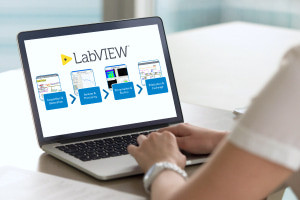Una piattaforma grafica di progettazione e sviluppo chiamata Laboratory Virtual Instrument Engineering Workbench (LabVIEW) è un ambiente di programmazione con linguaggio di programmazione visiva. È come disegnare un diagramma di blocco, ma invece di digitare un codice come si farebbe in linguaggi di testo come C# e VHDL, si sta disegnando. Mastering LabVIEW fornirà una solida base per l'apprendimento di altri software di controllo e hardware più facilmente.
Questo corso si propone di aiutarti a comprendere tutti gli aspetti concettuali di LabVIEW. Inizia con l'introduzione di LabVIEW e l'applicazione comune LabVIEW, oltre a confrontare LabVIEW con Strumenti tradizionali. Il flusso di dati di LabVIEW dei dati e l'ambiente LabVIEW verranno poi spiegati. Inoltre, si imparerà su un Virtual Instrument (VI), un pannello frontale, un diagramma di blocco e un riquadro Icon / Connector.
Le cose da sapere prima di iniziare la programmazione, come i tipi di dati comuni e le funzioni chiave LabVIEW, verranno discusse. Inoltre, esplorerai come eseguire LabVIEW. Capirete anche Express Vis, Vis, Funzioni, tavolozza strumenti e barra degli strumenti di stato. I lavori pratici riguarderanno la creazione di VI, le opzioni di guida, le tecniche di Debugging e la conversione di Celsius a Fahrenheit. Successivamente, comprenderete SubVIs, Per Loop, Mentre Loop e grafici. La sezione finale spiegherà come iniziare con Arrays.
What You Will Learn In This Free Course
View All Learning Outcomes View Less All Alison courses are free to enrol, study, and complete. To successfully complete this Certificate course and become an Alison Graduate, you need to achieve 80% or higher in each course assessment.
Once you have completed this Certificate course, you have the option to acquire an official Certificate, which is a great way to share your achievement with the world.
Your Alison certificate is:
- Ideal for sharing with potential employers.
- Great for your CV, professional social media profiles, and job applications.
- An indication of your commitment to continuously learn, upskill, and achieve high results.
- An incentive for you to continue empowering yourself through lifelong learning.
Alison offers 2 types of Certificate for completed Certificate courses:
- Digital Certificate: a downloadable Certificate in PDF format immediately available to you when you complete your purchase.
- Physical Certificate: a physical version of your officially branded and security-marked Certificate
All Certificate are available to purchase through the Alison Shop. For more information on purchasing Alison Certificate, please visit our FAQs. If you decide not to purchase your Alison Certificate, you can still demonstrate your achievement by sharing your Learner Record or Learner Achievement Verification, both of which are accessible from your Account Settings.










 Avg. Hours
Avg. Hours  CPD Accredited
CPD Accredited 

 Total XP:
Total XP: 
 Knowledge & Skills You Will Learn
Knowledge & Skills You Will Learn 






 Italiano
Italiano 

